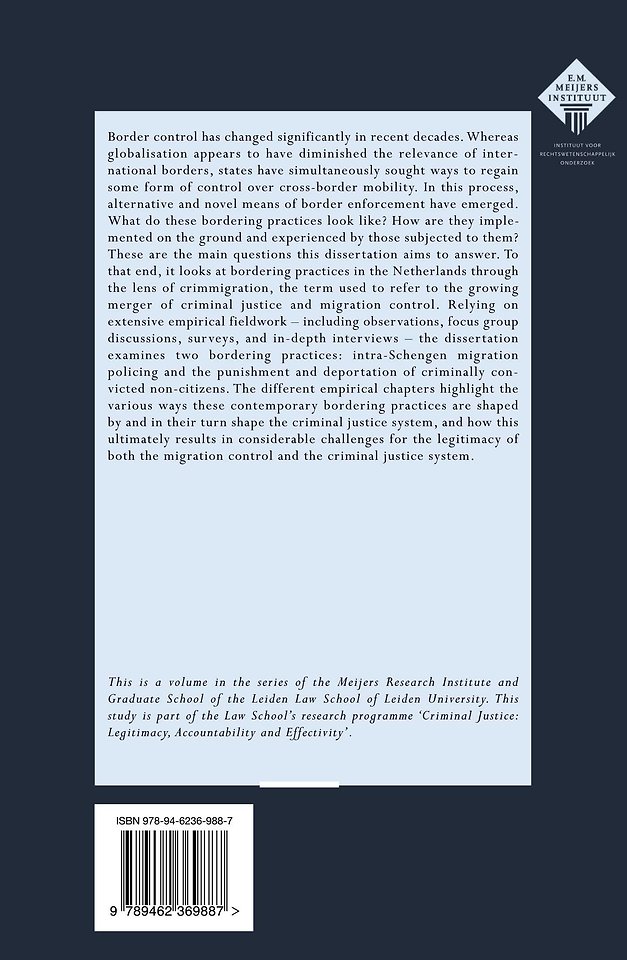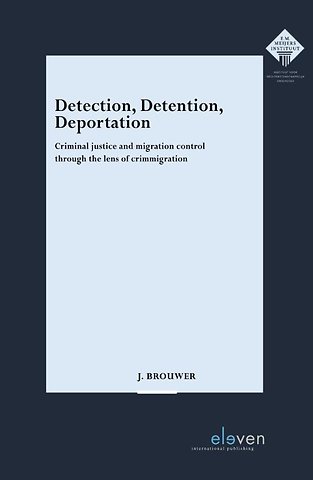Detection, Detention, Deportation
Criminal justice and migration control through the lens of crimmigration
Samenvatting
Border control has changed significantly in recent decades. Whereas globalisation appears to have diminished the relevance of international borders, states have simultaneously sought ways to regain some form of control over cross-border mobility. In this process, alternative and novel means of border enforcement have emerged. What do these bordering practices look like? How are they implemented on the ground and experienced by those subjected to them?
These are the main questions this dissertation aims to answer. To that end, it looks at bordering practices in the Netherlands through the lens of crimmigration, the term used to refer to the growing merger of criminal justice and migration control. Relying on extensive empirical fieldwork – including observations, focus group discussions, surveys, and in-depth inter views – the dissertation examines two bordering practices: intra-Schengen migration policing and the punishment and deportation of criminally convicted non-citizens.
The different empirical chapters highlight the various ways these contemporary bordering practices are shaped by and in their turn shape the criminal justice system, and how this ultimately results in considerable challenges for the legitimacy of both the migration control and the criminal justice system.
Specificaties
Inhoudsopgave
1.1 Finding the border in a time of globalisation 1
1.1.1 This dissertation 4
1.2 Crimmigration 6
1.2.1 Crimmigration: a bi-directional process 7
1.2.2 Membership theory 8
1.2.3 More outsiders, less rights 10
1.2.4 Ad-hoc instrumentalism 11
1.2.5 From criminal law and migration law to criminal justice and migration control 12
1.3 Crime, migration, and crimmigration in the Netherlands 15
1.3.1 Crimmigration in the Netherlands? 16
1.4 This dissertation 17
1.4.1 Crimmigration and the media 20
1.4.2 Crimmigration and intra-Schengen migration policing 21
1.4.3 Crimmigration, punishment, and deportation 22
PART I – CRIMMIGRATION AND THE MEDIA 25
2 FRAMING MIGRATION AND THE PROCESS OF CRIMMIGRATION: A SYSTEMATIC ANALYSIS OF THE MEDIA REPRESENTATION OF UNAUTHORISED IMMIGRANTS IN THE NETHERLANDS 27
2.1 Introduction 27
2.2 Agenda-setting, framing and moral panics: Why media representations matter 29
2.2.1 Terminology 30
2.3 Methodology 31
2.3.1 The corpus 33
2.4 Results 34
2.4.1 Discourse: Terminology 36
2.4.2 A criminal discourse? 37
2.4.3 Trends and developments 38
2.4.4 Differences between newspapers 40
2.5 Conclusion and discussion 40
PART II – CRIMMIGRATION AND INTRA-SCHENGEN MIGRATION POLICING 45
3 AT THE BORDER OF IMMIGRATION CONTROL: DISCRETIONARY DECISION-MAKING WITHIN THE MOBILE SECURITY MONITOR 47
3.1 Introduction 47
3.2 Discretionary decision-making and crimmigration 49
3.3 Discretionary power within the Mobile Security Monitor 51
3.4 Methodology 53
3.5 Between immigration control and criminal enforcement 55
3.6 Decision-making in an ambiguous context 57
3.7 Conclusion and discussion 60
4 (CR)IMMIGRANT FRAMING IN BORDER AREAS: DECISION-MAKING PROCESSES OF DUTCH BORDER POLICE OFFICERS 63
4.1 Introduction 63
4.2 Decision-making processes in context 65
4.3 Monitoring security in an expanding European Union 66
4.4 Methodology 67
4.5 Targeting immigration 68
4.6 Border policing and ethnic profiling 70
4.7 Targeting crime 72
4.8 EU expansion and the role of class 75
4.9 Generating and disseminating knowledge on whom to select 77
4.10 Conclusion and discussion 79
5 BORDER POLICING, PROCEDURAL JUSTICE AND BELONGING. THE LEGITIMACY OF (CR)IMMIGRATION CONTROLS IN BORDER AREAS 83
5.1 Introduction 83
5.2 Legitimacy, procedural justice and belonging 85
5.3 Methodology 87
5.3.1 Observational and focus group data 87
5.3.2 Survey data 88
5.3.3 Respondents 89
5.4 Decision-making, treatment and officer perceptions of procedural justice 90
5.5 Perceptions of those policed and differences between social groups 92
5.5.1 Perceptions of non-Dutch citizens 92
5.5.2 Perceptions of Dutch majority citizens 94
5.5.3 Perceptions of ethnic minority Dutch citizens 95
5.6 Conflicting perceptions of procedural fairness 99
5.7 Conclusion and discussion 101
PART III – CRIMMIGRATION, PUNISHMENT, AND DEPORTATION 105
6 BORDERED PENALITY IN THE NETHERLANDS. THE EXPERIENCES OF FOREIGN NATIONAL PRISONERS AND PRISON OFFICERS IN A CRIMMIGRATION PRISON 107
6.1 Introduction 107
6.2 Foreign national prisoners in the Netherlands 109
6.3 The pains of crimmigration prisons 111
6.4 Methodology 113
6.5 Experiencing the crimmigration prison 114
6.5.1 Prison officers in a crimmigration prison 115
6.5.2 Isolation and uncertainty in the crimmigration prison 116
6.5.3 Identity and belonging in the crimmigration prison 119
6.6 Conclusion and discussion 121
7 CAN I STAY OR SHOULD I GO? THE DEPORTATION OF CRIMINALLY CONVICTED
NON-CITIZENS IN THE NETHERLANDS 123
7.1 Introduction 123
7.2 The Dutch criminal deportation regime 125
7.2.1 Losing your residence permit following a criminal conviction 125
7.2.2 Ensuring the deportation of criminally convicted non-citizens 127
7.3 Theoretical background 128
7.4 Methodology 130
7.5 The implementation and lived experiences of criminal deportation 131
7.5.1 When the state is able to deport: “I have little hope they will release me here” 132
7.5.2 When the state is unable to deport: “I already planned to not cooperate anyway” 135
7.6 Conclusion and discussion 139
8 CONCLUSION 141
8.1 Introduction 141
8.2 Summary of empirical findings 141
8.2.1 Intra-Schengen migration policing 143
8.2.2 Criminal punishment and deportation 145
8.3 Answering the research question 147
8.3.1 To what extent are contemporary bordering practices in the Netherlands characterised by crimmigration? 148
8.3.2 Who is targeted by these bordering practices? 150
8.3.3 How are these bordering practices experienced and understood by those implementing them? 151
8.3.4 How are these bordering practices experienced and understood by those subjected to them? 152
8.4 Reflections and implications 153
8.4.1 Defining and understanding crimmigration 154
8.4.2 Crimmigration: a bi-directional process 154
8.4.3 Crimmigration: a broad concept 156
8.4.4 The drivers of crimmigration 158
8.4.5 Borders, crimmigration, and membership 159
8.4.6 Globalisation, migration control, and criminology 162
REFERENCES 165
ANNEX – RESEARCH METHODOLOGIES 193
Anderen die dit boek kochten, kochten ook
Net verschenen
Rubrieken
- aanbestedingsrecht
- aansprakelijkheids- en verzekeringsrecht
- accountancy
- algemeen juridisch
- arbeidsrecht
- bank- en effectenrecht
- bestuursrecht
- bouwrecht
- burgerlijk recht en procesrecht
- europees-internationaal recht
- fiscaal recht
- gezondheidsrecht
- insolventierecht
- intellectuele eigendom en ict-recht
- management
- mens en maatschappij
- milieu- en omgevingsrecht
- notarieel recht
- ondernemingsrecht
- pensioenrecht
- personen- en familierecht
- sociale zekerheidsrecht
- staatsrecht
- strafrecht en criminologie
- vastgoed- en huurrecht
- vreemdelingenrecht









